Database hydrodynamic and aerodynamic profiles
| Interactive data base HELICIEL | use XFOIL | Download performance data profiles for use in Heliciel | Use the interactive data base of Heliciel |
Understand and master the hydrodynamics and aerodynamics profiles Databases:
When we began designing a propeller or a wing , we find ourselves very quickly confronted with the choice of the profile, or rather, profiles, that give shape to our propeller or wing.- To select a profile aerodynamic or hydrodynamic, we must be able to evaluate its performance in the operating situation we are interested.
Curves Cl profiles tell us about the limits of stall :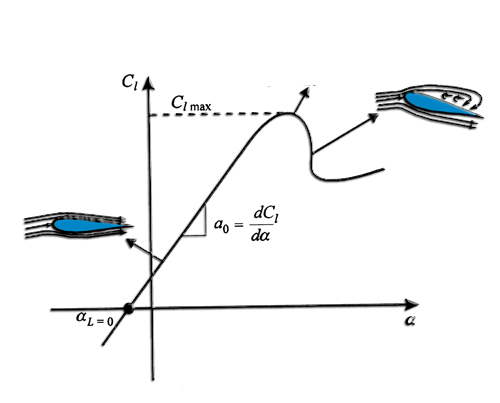
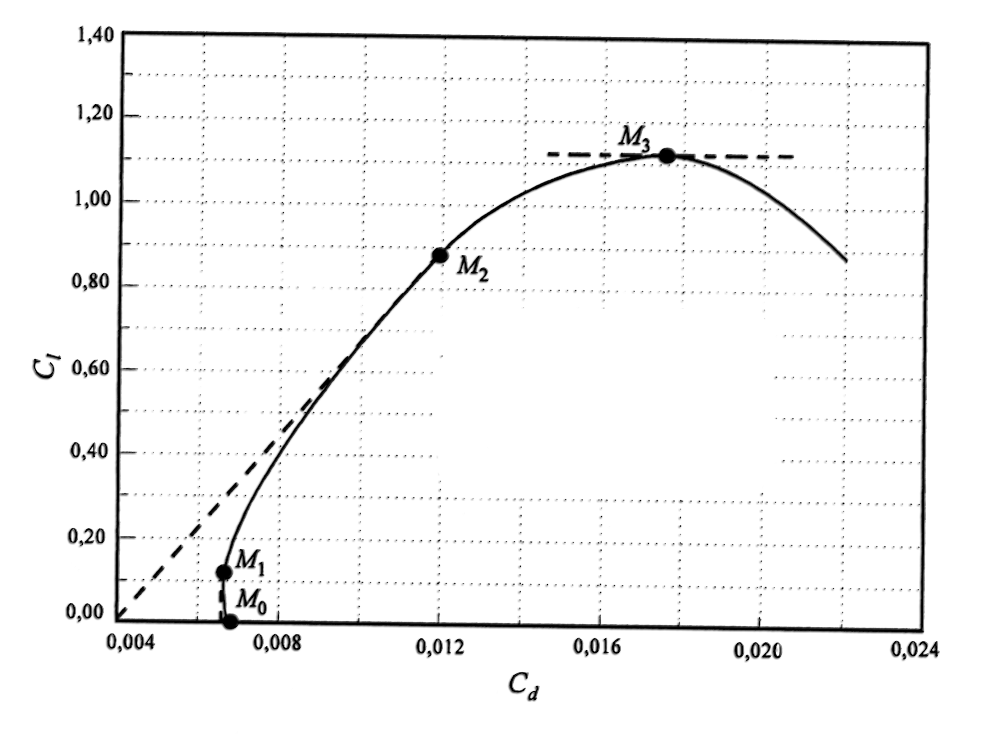
Curves Cd Cl (left) and polar depending on incident angles and Reynolds number in the database of Heliciel software.

To have on hand aerodynamic or hydrodynamic performance data seems essential to the success of the project. We can find this data in the literature or measured in wind tunnels on models. The time and resources devoted to this research data is not negligible and limiting us in our choice of profiles. A solution to this problem was partly found by numerical calculation and authors of digital wind tunnels programs.
Performance of a NACA edited for a Reynolds number selected in ... The interactive data base of HELICIEL software 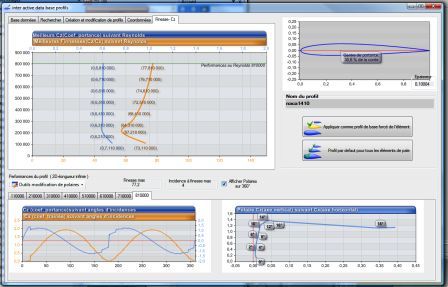
- The interactive data base communicates information héliciel profiles depending on the characteristics of geometry of the wing or propeller blade designed by the user. A selection is made among all the profiles of the database to provide the user with the most efficient profile (best cl / cd) that corresponds best to the blade or wing geometry .
User attempting to fly a Boa having swallowed an elephant ... Who said that this profile looks like a hat?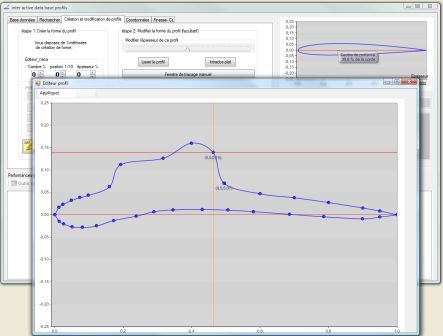
- Search and management functions of the database can record and create database derived, to include only profiles NACA or exclude symetrics profiles...
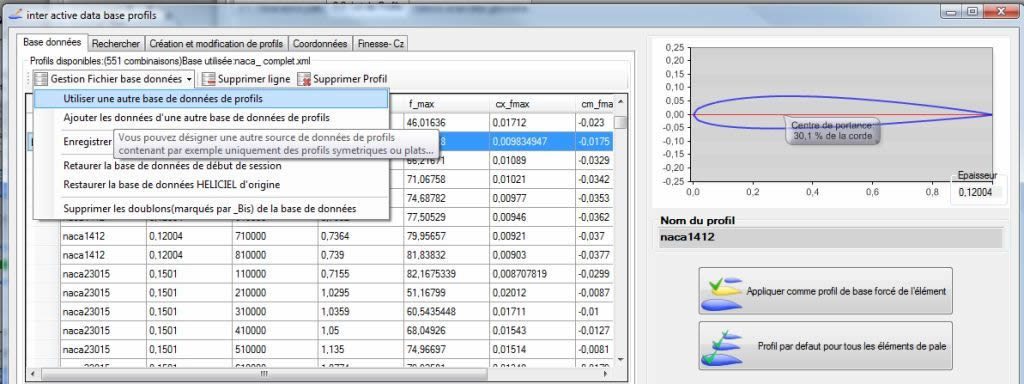
- The interactive data base Héliciel allows the user to draw a profile and calculate its performance by automatically controlling Xfoil. Performance data profiles provided by the interactive database are from the XFOIL piloting. Analysis and correction of unconventional results is made by interactive database, then Héliciel complete the polar 360 °, by symmetry (for symmetrical profiles) and insertion of flat plates performance for the values of incidence(attack angle) above the drop lift revealing the stall.
- XFOIL is an excellent wind tunnel. The software is free and distributed under the GNU General Public License (GPL). Here is the link to download site:
XFOIL (Mark Drela, MIT) XFOIL is an interactive program for the design and analysis of subsonic aerodynamic isolated. It consists of a collection of menu-driven routines which perform functions such as Analysis Profile taking into account the viscosity (Reynolds number)...
For more information about using database Heliciel: how to use interactive database.Download Database Performance profiles HELICIEL :
- HELICIEL offers free the result of hundreds of hours of automated calculations of performance profiles. The profiles performance data provided are derived from the autopilot XFOIL by The interactive data base Héliciel. Analysis and correction of unconventional results is made by interactive database, then Héliciel complete the polar 360 °, by symmetry (for symmetrical profiles) and insertion of flat plates performance for the values of incidence(attack angle) above the drop lift revealing the stall.. These data are provided for free as it is. Thank you to report any anomalies detected.
NACA Profiles:
- database profils_naca Heliciel3 9 M0. NACA profiles (High Definition 140 points)
Profiles aero / hydro dynamics with camber:
- database profils_naca Heliciel3_cambre 6.98 MB. profils NACA cambered
Profils aéro/hydro dynamiques symétriques:
- database_profils naca Heliciel3 symetrics Profiles only symmetrical about the x-axis (rope) for the design of rudders, hull type airships, submarines, boats cockpits and fuselages
- database profiles symmetrical about the axis X (chord) and y (vertical). This database enables the design of propellers whose performance is identical in forward or reverse.
conventional screw series profiles:The most widely used forms of marine blades. These profiles have a maximum thickness near the center of rope, which has the effect of spreading the maximum depression of the upper surface and therefore to push back the cavitation limit. These profiles edges sharp attack also provide good performance in reverse. These databases of profiles screw series are classified according to the number and type of blade which they are intended (B3=3blades,B4=4blades...) In each database profiles are named according to their position on the radius, and area ratio. The ratio of developed area allows you to quickly assess the blade surface-working that will generate thrust.Example: Profile B3-45-02D means that this profile is a one of a 3-blade propeller, covering 45% of the surface swept by the propeller disc, located at 0.2 times the radius blade tip
- database profils_B3-screw series the classical profiles screw series for 3 marine blades. 2.02 MB (low Definition)
- database profils_B4-screw series the classical profiles screw series for 4 marine blades. 2.51 MB (low Definition)
- database profils_B5-screw series the classical profiles screw series for 5 marine blades. 2.21 MB(low Definition)
- database profils_B6-screw series the classical profiles screw series for 6 marine blades. 1.02 MB (low Definition)
- database profils_B7-screw series the classical profiles screw series for 7 marine blades. 1.50 MB (low Definition)
How to add these databases,
to the interactive data base for use in Heliciel software?
- Download the database, decompress and save it in the folder: My Documents / Documents Heliciel/
- In the menu 'File data base management' from the interactive data base HELICIEL, select ' use another database profiles ' and select the downloaded base.
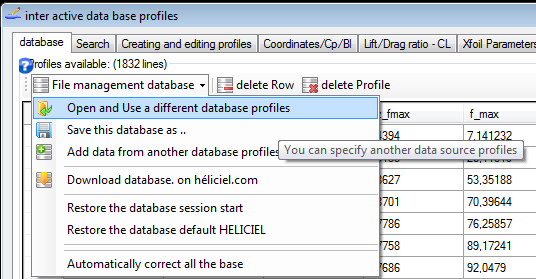
A warning message 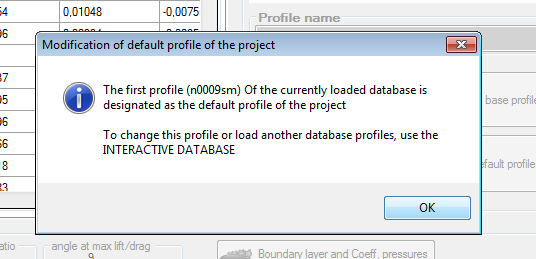 informs you that the default profile for your project has been changed (if the database loaded does not contain it).
informs you that the default profile for your project has been changed (if the database loaded does not contain it).
- You can then use the law profiles to control how Heliciel use your profiles, or choose the profile that elements of your blade will use
For more information about using database Heliciel: how to use interactive database.

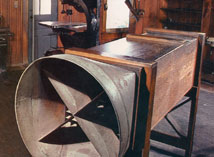
 Global site map
Global site map Mecaflux
Mecaflux Tutorials Mecaflux Pro3D
Tutorials Mecaflux Pro3D Tutorials Heliciel
Tutorials Heliciel Mecaflux Store
Mecaflux Store Compare software functions
Compare software functions Quotes, Orders, Payment Methods
Quotes, Orders, Payment Methods project technical studies
project technical studies